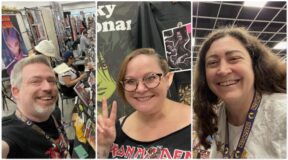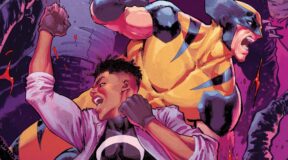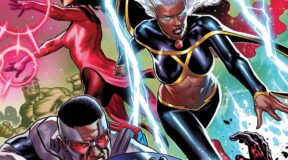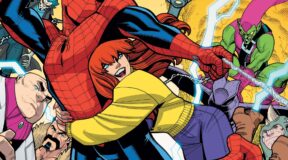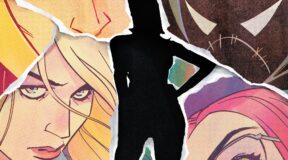I’ve returned home from another successful Dragon Con in Atlanta and was lucky and honored to get the opportunity to spend time with some amazing comic book creators who were generous enough with their time to speak with me about what inspired them, what they are working on and what books they think any comic book fan should read.
Zoe Thorogood is the Eisner nominated and award winning writer and artist of original graphic novels like It’s Lonely at the Centre of the Earth as well as runs on Hack/Slash for Image Comics and co-creating Spider-UK for Marvel Comics and providing the art for the adaptation of Joe Hill’s novella Rain.
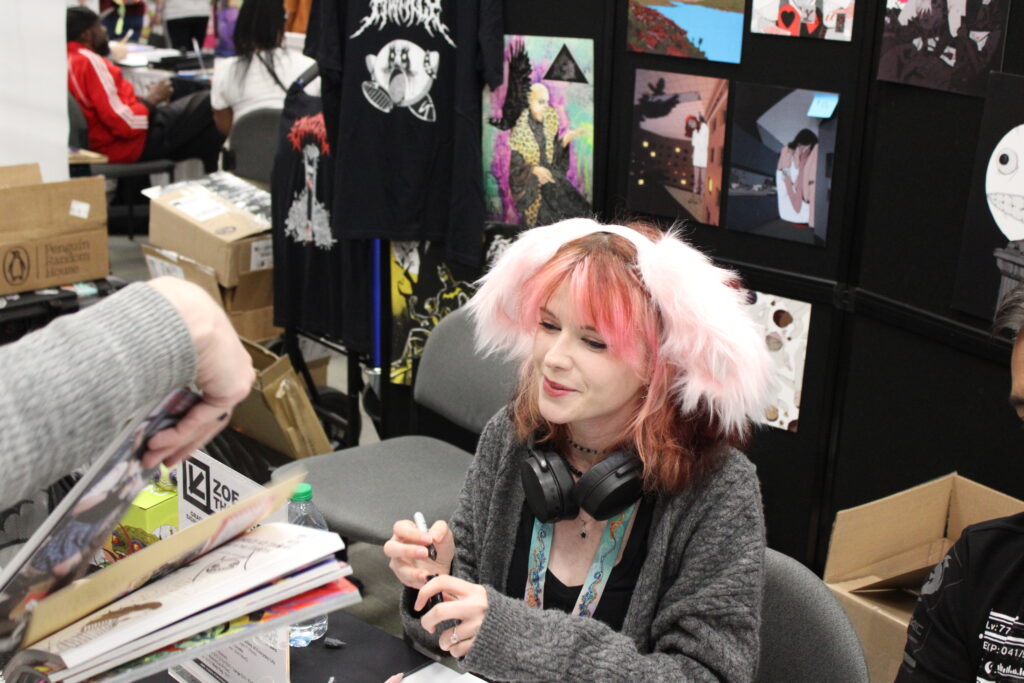
SPF: Is there a piece of medium or a comic that inspired you to get into comics?
ZT: So I was actually mostly inspired by video games. Actually, as a kid, I really only got into comics in the middle of my teens. But before that, I was super into video games. But a lot of the games that I really loved were stuff like Borderlands. There’s very comic inspired art in those games. That really, really appealed to me. I think it’s partly that one of the biggest artistic inspirations for me was Borderlands. Comic-wise, I started getting into manga when I was about 14 and I remember the first one that I read that blew me away was Death Note and I think that was one of the things where it was like, you know just this black and white art on paper can just like tell the story and feel so thrilling. So I’d say Borderlands was my big influence, my main as a child, but then comic wise Death Note really like, showed me more.
SPF: What work do you have coming up that you like for people to read? What are you currently working on that you can talk about?
ZT: So my current project is kind of a strange one, kind of like a sad project. I unfortunately lost my brother last year and I was working on a different book at the time called Head Trauma, which I was really getting excited about. But then my brother died and I was working on Head Trauma and I was realizing everything I was writing was becoming about him because it was like all my mind could think of. So I put Head Trauma on the back burner and I thought I need to make a project that’s going to process these feelings I have. So I started a project called It Took My Brother and it’s a it’s a fantasy sci-fi story about two boys and one of them is killed by a monster and the surviving brother sets out on a revenge mission to kill this monster and it’s very obviously based off what I went through but in this fantasy setting so I can distance myself and I can, you know, tell this story that I wanted to be this all ages kind of story. It’s about this young boy and there’s monsters and there’s fairies and there’s all these like fantasy things going on. But at its core it’s a very, very, simple story about loss and grief and just helping me process.
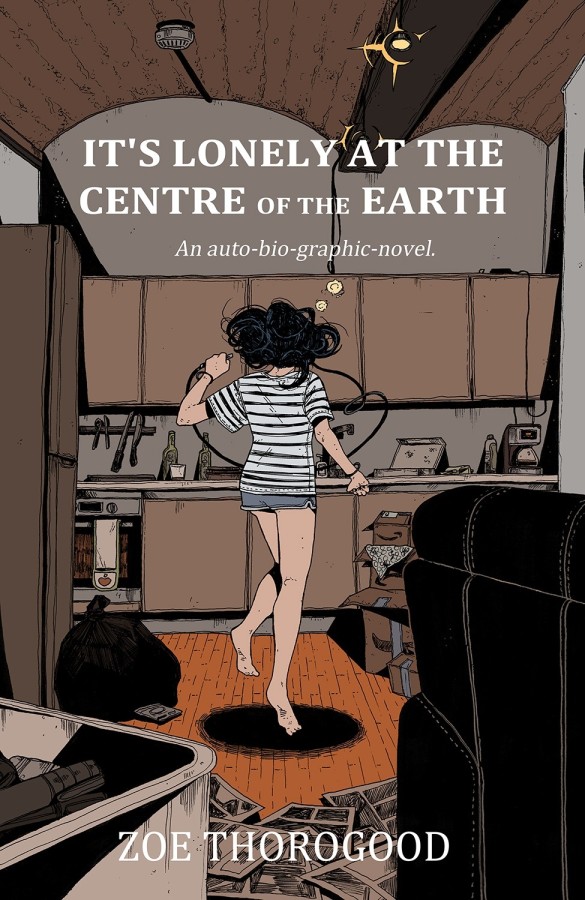
SPF: That sounds really interesting. Do you have anything that’s currently available that you recommend for people to read of yours?
ZT: Well, my main book is my autobiographical comic that I put out about three years ago It’s Lonely at the Center of the Earth. So anybody who’s interested in my work, I tend to recommend that one because it’s kind of the wildest thing that I probably put out, but I’ve also put out like my first book was The Impending Blindness of Billie Scott, which is a lot more of a standard comic. It follows a young artist as she’s losing her eyesight. Everything I make is pretty emotional. (laughs)Yeah.
SPF: They are very personal. That’s one of the reasons why I loved your work on Rain and It’s Lonely (at the Center of the Earth) so much when I read them the first time. My last question is, is there a book or run that you would recommend? It could be your work or somebody else’s, that connected with you that you think other people would connect with.
ZT: Um. This is probably really a really lame answer, because I think it’s probably what a lot of people say. Saga. I just think it’s inspired a lot of what I’m doing currently because it’s this big fantasy world and there’s all this incredible creativity. But at its core, it’s like a fairly simple story. I love things like that and it feels just so many of the characters are relatable. So many of the issues are so current to our world but its really wondrous.
SPF: But it’s through the lens of a giant fantasy.
ZT: Right. And I haven’t experienced anything like it.
Alyssa Wong is the award winning writer of novels like The High Republic: Escape from Valo and comics like Star Wars: Doctor Aphra, Iron Fist, Deadpool and Psylocke.
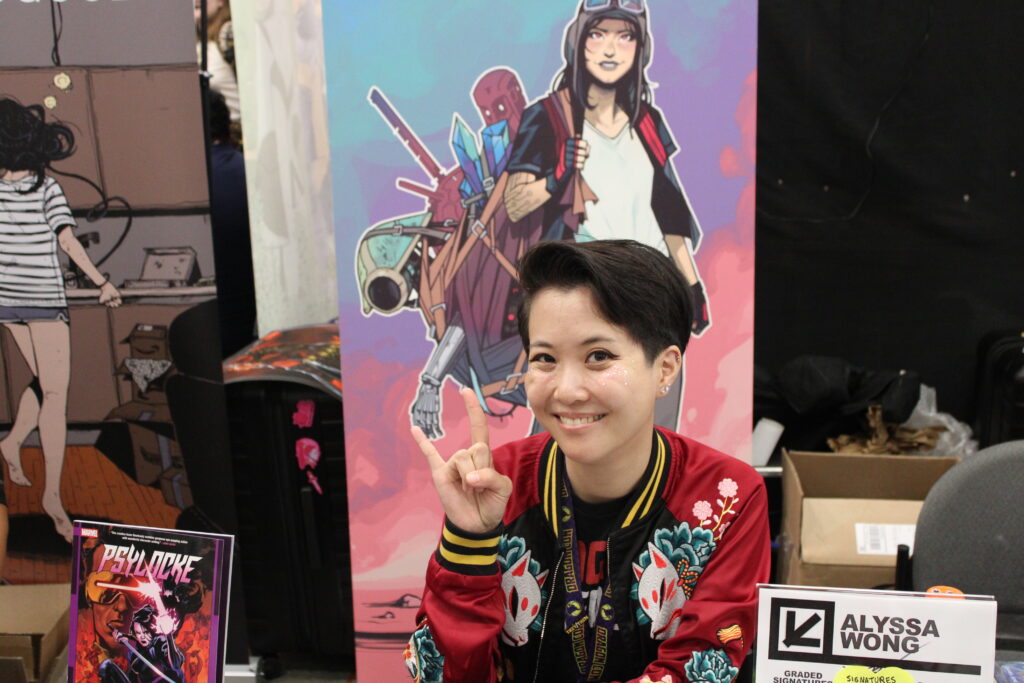
SPF: So my first question is, was there a specific piece of art or comic or book that inspires you to get into writing comics?
AW: I’ve written as long as I can remember, and I always wrote for myself. My dad used to tell me stories all the time as a kid, and then I would just make my own up. In terms of comics, I read a lot of manga growing up and my big inspiration, honestly, is Junji Ito. Beautiful horror comics, incredible short stories. My favorites are definitely his short, one-shot stories. Absolutely beautiful.
SPF: Do you have an upcoming project that you love that you can talk about?
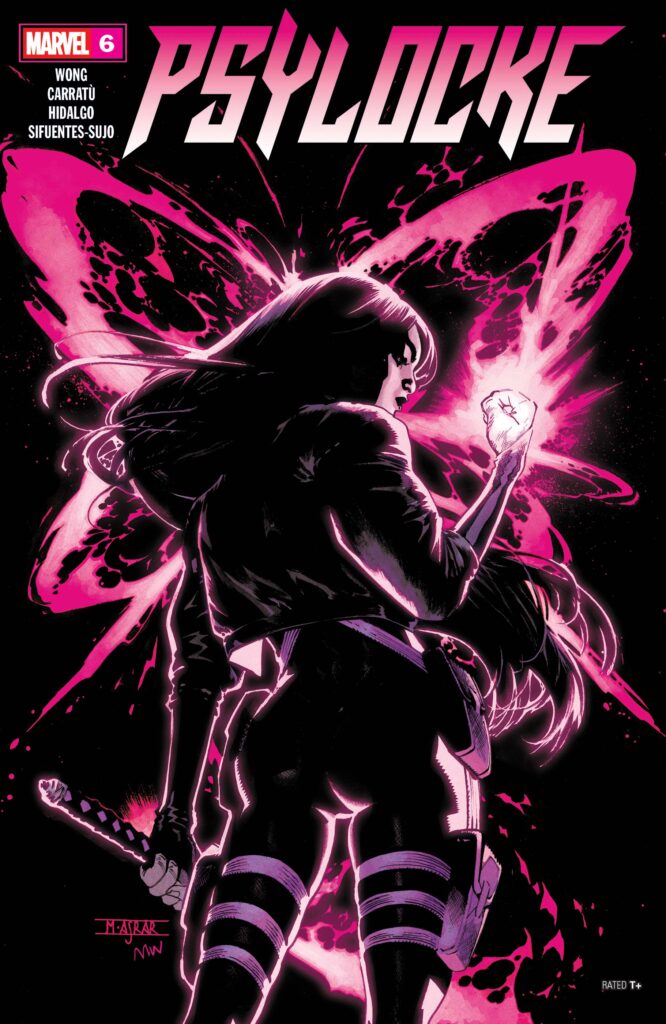
AW: I think legally, I can’t tell you anything, but, I’m excited for everything I’m writing. Please, if you want, keep an eye out, perhaps, for something new. And if you’re looking for something that I’ve written very recently, I’ve been writing Psylocke for Marvel. I’ve been writing Psylocke from Marvel, and I love that book. The last issue just came out, Ten issues. If you’re looking for something to try, I highly recommend that.
SPF: Is there a title or run, yours or somebody else’s, that you would recommend to a comic fan?
AW: I’ve got two for you. One is a comic and one is a graphic novel. I’m a huge Kieron Gillen fan. Huge Kieron Gillen fan. The Wicked and the Divine is really the first comic where I was like, oh, beyond manga, I want to read American comics. I want to read British comics. I want to read comics in English. I was like, this is a whole world that has opened up to me. So obviously, The Wicked and the Divine. However, there’s also a graphic novel that I think is incredible. It’s called The Magic Fish. It’s by Trung Le Nguyen, who is amazing. It came out, I think, last year (2020) and won several awards. His debut graphic novel, and it is about fairy tales and connecting with family and the stories you both tell each other generationally, and that you don’t. They made me cry. Like six times. It’s beautiful and so good. Check it out.
Tom DeFalco is a legendary writer of iconic comic book runs on Amazing Spider-Man, Thor and Fantastic Four as well as creating the Mayday Parker version of Spider-Girl, co-creating Silver Sable, co-writing the infamous “Clone Saga” as well as “Maximum Carnage” and introducing Spider-Man’s iconic black costume which would eventually become the Venom symbiote.

SPF: My first question is, is there a piece of literature, a piece of art? It doesn’t it didn’t have to be a comic or anything like that, that inspired you to get into comics as a medium?
TDF: It’s you know, hard to answer. At a very early age, I kind of discovered comics and then started to kind of do comics at an early age. I knew that I was ultimately going to be a writer. I just like telling stories. The comics I liked tend to be written by two different guys, Stan Lee and Robert Kanigher. And I thought, I’m not either one of those guys and I’m not members of their family, so I’m not going to write comic books. So I concentrated on prose and all sorts of other things. I don’t remember if my first professional sale was an article to a newspaper or a short story, because around the same time as when I started writing and stuff.
SPF: I understand. It was about being prolific. Writing whatever you could.
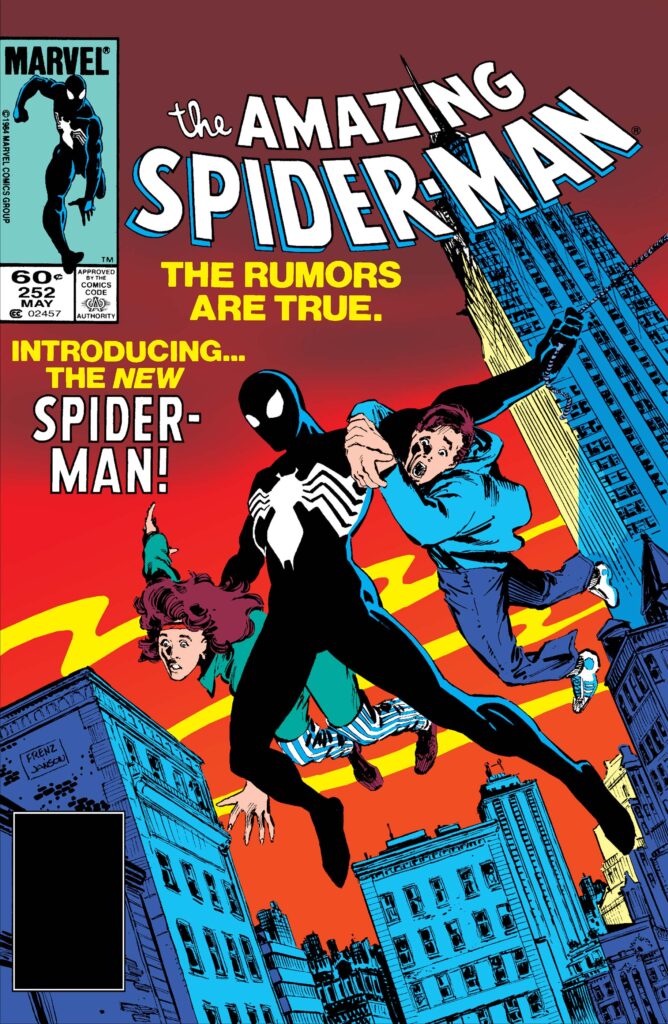
TDF: Yeah. In college, working for a local giveaway newspaper, writing all sorts of reviews and stuff. And then ended up writing for the local daily paper and PR plays and the occasional short story. I was a very lucky guy, you know, sent in short stories, and they bought it for an amazing sum of money, which would probably be about $25 bucks at the time. I didn’t realize how hard it was to actually keep going because they kept buying them (laughs). When I got out of college, I sent out resumes and ended up getting a call from Archie Comics and then started in their editorial department.
If there were two comic books that really inspired me, Fantastic Four #3 and #4, which I bought together. If there was one author that really inspired me was Edgar Rice Burroughs. I was 10 or 11 years old when I first discovered those books,
SPF: Tarzan. John Carter.
TDF: Tarzan, the Martian books, etc. I plot stories following Edgar Rice Burroughs example. He would have a scene with people, and they would suddenly be in danger. Then he’d have another group and they would get in danger. Go back and they cut to a third group. I still plot my stories that way. I used to look at the Edgar Rice Burroughs stuff and realized that they were all essentially romance novels. Is Tarzan going to get the girl? Is John Carter going to rescue the princess? Even today, I said to my wife, you know, I just write love stories. She says, It’s a psychotic killer in this. Yes, but at its essence…(laughs). Okay, yeah, there are zombies trying to take over. But, you know, it’s really a love story between this character and that character. I’d say Edgar Rice Burrough really, really inspired me to be a writer.
SPF: My next question is, is there a book that you would recommend that you think is essential for a comic book fan to read? It could be your own work. It can be somebody else’s work. Just something that you think has enough of a cultural impact to comic book fans.
TDF: You know. the Stan Lee and Jack Kirby Fantastic Four, almost any issue. Stan Lee and Steve Ditko’s Spider-Man, almost any issue. Even when the Fantastical plots make no sense. The story was just compelling. In my own work, the story I look back on where I think, “Hey, Ron (Frenz) and I can actually do Spider Man.” We did a story called, Whatever happened to Crusher Hogan, and it was one of those stories where we see Peter Parker’s humanity and sense of responsibility come out. Yet, at the end, he disappoints Aunt May, and he walks away feeling like a total loser.
That was the one story where I thought. Hey, we can actually do this, because I know Ron Frenz and I were on Amazing Spider-Man and we kept thinking, you know, we’re not good enough this. They’re going to bring in real people at some point or another. But that was the one that they said to me, you know, we may actually know what the heck we’re doing.
SPF: My last question, is there anything that you’re currently working on that you can talk about or something that maybe has come out recently that you’d like people to pick up?
TDF: Well, recently, Ron Frenz and I did a Thing story featuring the Sandman and their relationship. It’s a 10-page story with, you know, two or three subplots. All of them that reflect the same theme. With Ron we do stories with actual themes. We’re very strict constructionists. We have also just completed a story starring, I’m going to say, the Venom symbiote. That’s going to appear in Venom #252. You can’t figure out why they chose this for Venom #252? You can figure that out, can’t you?
SPF: Because Spider-Man’s black suit first appeared in Amazing Spider-Man #252 which you wrote.
TDF: Yeah. So those are the next two things in comics for me. There are some other projects I can’t talk about yet.
SPF: Completely understandable. I will definitely check them out when you do.
I want to once again thank all of the creators who took the time to talk to me this year at Dragon Con as well as the organizers who did an amazing job of creating not only an amazing convention area but also an awesome Artist Alley for both creators and fans. Can’t wait to see you all again next year.
